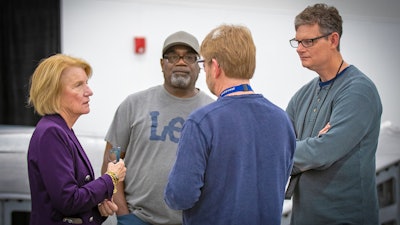
Last Wednesday, Boeing subsidiary Aurora Flight Sciences held a grand opening event to debut its advanced manufacturing expansion in Bridgeport, West Virginia.
The development will add some 50,000 square feet to the facility and support growth in current production programs and new aerospace opportunities.
The Bridgeport facility makes components and systems for advanced aircraft, like the MQ-25 Stingray, T-7A Red Hawk, and military helicopters.
The expansion increases the facility's footprint to approximately 227,000 square feet. The new factory doubles the size of the clean room, adds a new autoclave, installs permanent freezers, and creates adequate space to implement point-of-use tooling safely.
Most Read on IEN
- Boeing, Lockheed Passed Up for Air Force Drone Program
- Latest Formula E Race Car Goes from 0-60 MPH in 1.82 Seconds
- NASA Astronauts Arrive for Boeing's First Human Spaceflight
- The Mars Sample Return Mission Has a Shaky Future
Aurora previously announced that the facility in West Virginia would build the airframe for DARPA's X-65 active flow control demonstrator aircraft. The plant will also provide the transonic-truss-braced wing assembly for NASA's X-66 sustainable flight demonstrator aircraft.
DARPA selected Aurora for phase three of the CRANE program. Aurora will build a full-scale X-plane to demonstrate the test the use of active flow control (AFC) actuators for primary flight control. AFC could replace the flaps and rudders used to maneuver most aircraft.
For the X-66, Aurora is modifying an MD-90 aircraft as part of a NASA collaboration. Aurora is removing the jet's original wings to test a Transonic Truss-Braced Wing (TTBW) design with new ultrathin wings braced by struts with larger spans and higher aspect ratios. NASA says the new wing design should produce less drag with longer, thinner wings supported by aerodynamic trusses.
The grand opening was attended by employees and state and local leaders, like Governor Jim Justice, and U.S. Senator Shelley Moore Capito.
Aurora opened its first West Virginia location in 1994. The 68,000-square-foot composite materials and prototyping facility was located in Fairmont. The company moved to Bridgeport in 1999, starting with a single building but growing into a six-building campus.
The site is already home to advanced manufacturing technology, like a robotic composite manufacturing cell that uses robots for precise part machining, transport, and dimensional inspection.
Aurora plans to add more than 100 new jobs in the next five years.
Click here to subscribe to our daily newsletter featuring breaking manufacturing industry news.






















